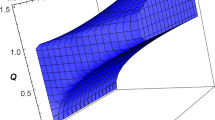Abstract
Numerical studies of black hole greybody factors indicate that Hawking emission from a highly rotating black hole is strongly spin dependent, with particles of highest spin (gravitons) dominating the energy spectrum. So far, there has been no analytic explanation or description of this effect. Using “gravitomagnetism”, or the formal analogy between the Maxwell’s field equations for electromagnetism and Einstein’s equations for gravity, we were able to establish a link between the spin of the rotating black hole and spin of an emitted particle. Namely, the intrinsic spin of the particle creates a “mass dipole moment” which interacts with external gravitomagnetic field whose source is the rotation of the black hole. We showed that a rotating black hole prefers to shed its spin, i.e. tends to emit particles with the spin parallel to its own. We also showed that the probability for emission grows with the increasing spin of the emitted particles. The amplification factors can be huge if a black hole is highly rotating, i.e. close to extremal. When applied to central galactic black holes, the same physical mechanism indicate that particles orbiting around these black holes should have spins strongly correlated with the spin of the black hole, which may have implications for cosmic rays believed to be coming from these regions of space.
Similar content being viewed by others
References
R.H. Dicke, Coherence in spontaneous radiation processes, Phys. Rev. 93 (1954) 99 [SPIRES].
Y.B. Zeldovich, Generation of waves by a rotating body, Pisma Zh. Eksp. Teor. Fiz. 14 (1971) 270 [JETP Lett. 14 (1971) 180].
Y.B. Zeldovich, Amplification of cylindrical electromagnetic waves reflected from a rotating body, Zh. Eksp. Teor. Fiz. 62 (1972) 2076 [Sov. Phys. JETP 35 (1972) 1085].
W. Unruh, Separability of the neutrino equations in a Kerr background, Phys. Rev. Lett. 31 (1973) 1265.
D.N. Page, Particle emission rates from a black hole. 2. Massless particles from a rotating hole, Phys. Rev. D 14 (1976) 3260 [SPIRES].
V. Frolov and I. Novikov, Black hole physics: basic concepts and new developments, Springer, Germany (1998) [SPIRES].
V.P. Frolov and D. Stojkovic, Quantum radiation from a 5-dimensional rotating black hole, Phys. Rev. D 67 (2003) 084004 [gr-qc/0211055] [SPIRES].
V.P. Frolov and D. Stojkovic, Black hole radiation in the brane world and recoil effect, Phys. Rev. D 66 (2002) 084002 [hep-th/0206046] [SPIRES].
V.P. Frolov and D. Stojkovic, Black hole as a point radiator and recoil effect on the brane world, Phys. Rev. Lett 89 (2002) 151302 [hep-th/0208102] [SPIRES].
D. Stojkovic, Distinguishing between the small ADD and RS black holes in accelerators, Phys. Rev. Lett. 94 (2005) 011603 [hep-ph/0409124] [SPIRES].
D.-C. Dai et al., BlackMax: a black-hole event generator with rotation, recoil, split branes and brane tension, Phys. Rev. D 77 (2008) 076007 [arXiv:0711.3012] [SPIRES].
D.-C. Dai et al., Manual of BlackMax, a black-hole event generator with rotation, recoil, split branes and brane tension, arXiv:0902.3577 [SPIRES].
D.-C. Dai, N. Kaloper, G.D. Starkman and D. Stojkovic, Evaporation of a black hole off of a tense brane, Phys. Rev. D 75 (2007) 024043 [hep-th/0611184] [SPIRES].
M. Casals, S.R. Dolan, P. Kanti and E. Winstanley, Bulk emission of scalars by a rotating black hole, JHEP 06 (2008) 071 [arXiv:0801.4910] [SPIRES].
E. Jung, S. Kim and D.K. Park, Condition for the superradiance modes in higher-dimensional rotating black holes with multiple angular momentum parameters, Phys. Lett. B 619 (2005) 347 [hep-th/0504139] [SPIRES].
O.J.C. Dias, R. Emparan and A. Maccarrone, Microscopic theory of black hole superradiance, Phys. Rev. D 77 (2008) 064018 [arXiv:0712.0791] [SPIRES].
I. Bredberg, T. Hartman, W. Song and A. Strominger, Black hole superradiance from Kerr/CFT , JHEP 04 (2010) 019 [arXiv:0907.3477] [SPIRES].
B. Mashhoon, Gravitoelectromagnetism, gr-qc/0011014 [SPIRES].
R.M. Wald, Gravitational spin interaction, Phys. Rev. D 6 (1972) 406 [SPIRES].
L.I. Schiff, Motion of a gyroscope according to Einstein’s theory of gravitation, Proc. Nat. Acad. Sci. 46 (1960) 871 [SPIRES].
B. Mashhoon, Particles with spin in a gravitational field, J. Math. Phys. 12 (1971) 1075 [SPIRES].
Author information
Authors and Affiliations
Corresponding author
Rights and permissions
About this article
Cite this article
Dai, DC., Stojkovic, D. Analytic explanation of the strong spin-dependent amplification in Hawking radiation from rotating black holes. J. High Energ. Phys. 2010, 16 (2010). https://doi.org/10.1007/JHEP08(2010)016
Received:
Revised:
Accepted:
Published:
DOI: https://doi.org/10.1007/JHEP08(2010)016



